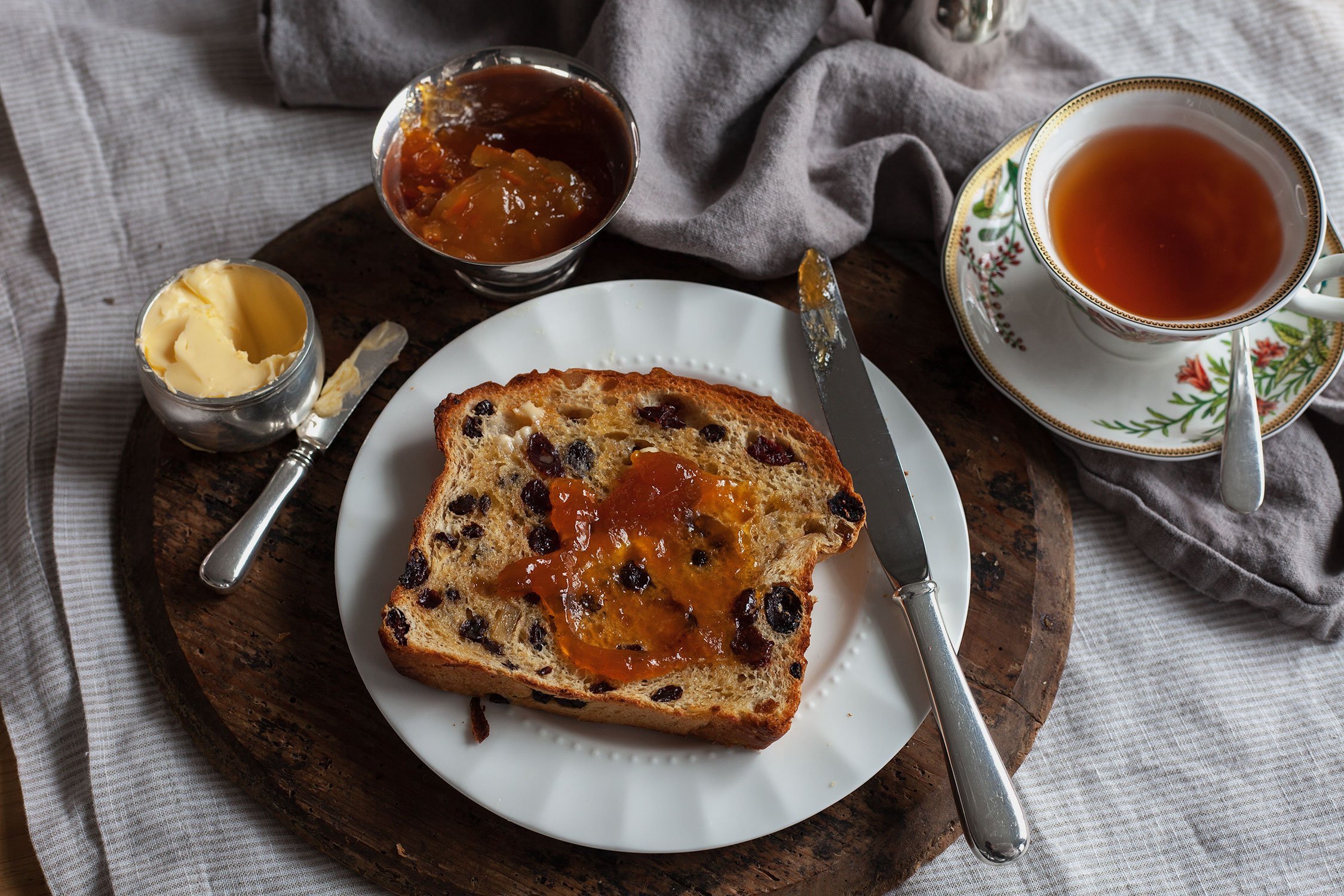Irish Barmbrack with Orange Scented Apricot Butter
Well, this is my take on an Irish Barmbrack. A few years ago, I helped my son make barmbrack for his sixth grade country report after he spent the year studying Ireland. I followed a simple quick bread version and made what the internet told me was a traditional barmbrack: a spiced tea cake made with raisins that have been soaked in tea. It wasn’t until I saw this episode of City Bakes (time stamp 17:43) that I learned that sometimes barmbrack is made with a risen dough.
I’m one of those semi-rare Americans who actually likes fruit bread and fruitcake (I mean, it has to be good fruitcake), so when I saw the video, and realized that the bread is usually a Halloween tradition and we were right in the middle of October, I had to try and make it for myself.
What follows is the recipe from my first attempt at copying Bread Naturally’s barmbrack, and though it’s similar, I referenced the quick bread loaf I had made for my kid’s school presentation, as well. I also used the ingredients I had on hand, so I included dried cranberries and dried tart cherries. They’re much perkier than raisins, and I thought they were a great addition. I also couldn’t find candied orange peel in a pinch, so I added lemon zest and candied ginger. To make up for the orange peel, I found orange essential oil in my cupboard and added that to the glaze, which turned out to be a revelation. I want to add that stuff to everything now.
The dough rose much easier and quicker than I expected (probably because I was using a fresh bag of Saf-instant with the gold label. Apparently it’s specifically for breads with fruit or eggs or butter (or all three!), which would give other yeasts a harder time. (So if you can’t find it, I would suggest adding an extra teaspoon of whatever yeast you have.)
The barmbrack turned out amazing. I have no idea how close to the original it tasted, though, and I hadn’t hidden any rings or coins inside, so it was far from traditional, but it was a delicious, spicy, fall-ish tasting fruit bread that I will want to make every October for the rest of my life.
I brought some of the second loaf (not in the picture) to my in-laws, and between the three of us, we devoured the whole thing that night. What you see in the picture is actually the “hero” loaf (food photographer lingo), but the sun had gone down by the time it was cool enough to slice, so what you’re seeing is the prettier loaf, but a day old, and therefore looks much drier than how it actually was on the day I baked it. If you make this recipe, I would recommend freezing anything you don’t eat on the day you bake it, and that should stop the drying out process.
Next time I make it, I’ll most likely double the amount of dried fruit (just to see if I can get the ratio more like the one in the video), add a little more butter, and try to incorporate the Japanese tangzhong method to make the dough chewier and last a couple more days.
But for now, as it is, it’s a wonderful loaf of bread. And for this Italian-English-German-Scottish-(and ever so slightly)-Irish-American, it was a perfect barmbrack for Halloween.
Tea pairing: I served the barmbrack with Stash’s Breakfast in Paris, which you can find out more about in my YouTube video right here.
Irish Barmbrack with Orange Scented Apricot Butter
Bag of strong tea, such as Yorkshire Gold, or a non-minty herbal tea*
1/2 cup boiling water
1/2 cup dried cranberries left whole
1/2 cup tart cherries, left whole
1/2 cup sultanas
1 cup currants
1 cup crystallized ginger, chopped
Zest of one lemon
Zest of an orange (not in my original recipe)
4 cups bread flour, divided
1 teaspoon coarse salt
1 heaping tablespoon yeast** (I used Saf-instant with the gold label)
1/2 teaspoon ground cinnamon
1/4 teaspoon ground ginger
1/4 teaspoon ground cardamom
1/8 teaspoon ground cloves
1/4 teaspoon ground nutmeg
1 cup milk, warmed slightly
1/4 cup water
3 yolks
1 egg
1 tablespoon honey
3 tablespoons butter, at room temperature
For the glaze:
2 tablespoons butter, melted
1/4 cup apricot preserves
5-6 drops orange essential oil (food grade—I used the Now brand)
~or~
Zest of one orange
In a mug or liquid measuring cup, brew the tea in the 1/2 cup of boiling water for 3-5 minutes. Measure out the fruit into a large glass bowl and stir in the hot tea. Set aside.
Place the first 3 1/2 cups of flour in the bowl of an electric stand mixer fitted with the dough hook. Pour the yeast in a small pile on one side of the flour, and place the salt in a small pile on the opposite side (this keeps the salt and yeast separate, at least at the beginning, so that the salt doesn’t slow down the yeast). Add the spices. With the mixer on low, pour in the milk, water, egg yolks and egg, honey, and butter. Scrape down the bowl as necessary to get any of the dry ingredients to mix with the wet ingredients. Turn the mixer to medium low and let it knead the dough for 10 minutes, or until you can see strands of gluten pull away from the sides of the bowl.
Drain the fruit and discard the liquid. Add the fruit to the dough, and turn the mixer to low. Sprinkle the remaining flour, little by little, onto the wet fruit, which will help the dough cling to the fruit. Knead until all the fruit is incorporated.
Detach the bowl from the mixer and cover with plastic wrap and let rise in a warm, draft-free space. Take note of how big the ball of dough is (I sometimes snap a picture with my phone), and let rise until doubled in size, 45-60 minutes.
While the dough rises, butter two medium loaf pans (or if you want to make it the way I did, I buttered and lined a 7-inch round springform cake pan with parchment paper, and buttered a second medium loaf pan).
Pull the dough out, and place on a floured board. Flatten the dough with your hands and knead a few times. Divide the dough in half and shape into two loaves. Place in the prepared pans, cover with buttered plastic wrap, and let rise until doubled, another 45-60 minutes.
Preheat the oven to 350 degrees Fahrenheit, and place the loaves on the center rack. Bake for 15 minutes.
While the bread is baking, prepare the glaze.
Heat the apricot preserves in the microwave for 30 seconds. Stir, and press through a sieve. Mix in the butter, and orange oil or zest. Pull the bread out, and using a pastry brush, very gently brush the tops of the bread with the glaze.
Return the loaves to the oven and continue to bake until the tops of the bread is dark and golden and the bread is baked through, another 15 minutes. If you have a thermometer, check the internal temperature to ensure the center of the bread is 190 degrees Fahrenheit.
Let the bread cool on a wire rack for 10 minutes inside the pans. Then remove from the pans and place directly on the wire racks until cooled completely . . . or until you just can’t wait anymore. Serve with Orange Scented Apricot Butter (recipe follows).
Orange Scented Apricot Butter
6 tablespoons salted butter, at room temperature
1 cup (8 ounces) apricot preserves
8-10 drops orange essential oil
~or~
Zest of one orange
Make sure that butter is very soft and then stir into apricot preserves (no need to strain). Whisk in the orange oil, to taste. Place in a small bowl, and serve. Can be stored in an airtight container, refrigerated, for up to a month.
*To be perfectly frank, I don’t find that the tea affects the flavor of the bread very much. So don’t stress over this one way or the other. You could use hot water, or juice, or wine, or whiskey (the whiskey would make a difference in taste, though!). It’s really up to you. The main thing is to reconstitute the fruit so that it isn’t too dry or chewy.
**To make sure your yeast is going to work, place 2 tablespoons of warm water (110 degrees F) in a small bowl and stir in about 1/2 a teaspoon of yeast with a pinch of sugar. Let this sit for about 5 minutes. If it gets foamy, your yeast is still good. If it doesn’t bubble much at all, or it’s really taking it’s time, then you’ll need a new container of yeast. For a recipe like this, when the ingredient list is really extensive, I wouldn’t skip this step. There’s nothing worse than mixing it all together, and then wondering if it’ll rise, especially when yeast can struggle to get bread with eggs and fruit to rise. If you’ve tested it, you’ll know you’re good.
*** Depending on the strength of yeast and the temperature of the house, this could actually take anywhere from 30-90 minutes.




